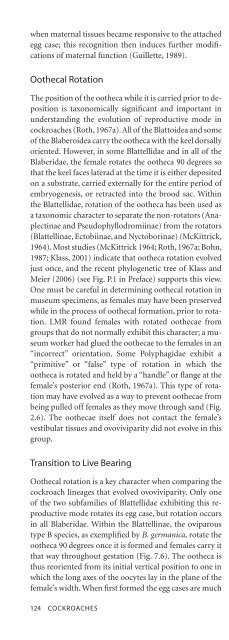Cockroache; Ecology, behavior & history - W.J. Bell
Cockroache; Ecology, behavior & history - W.J. Bell
Cockroache; Ecology, behavior & history - W.J. Bell
Create successful ePaper yourself
Turn your PDF publications into a flip-book with our unique Google optimized e-Paper software.
when maternal tissues became responsive to the attached<br />
egg case; this recognition then induces further modifications<br />
of maternal function (Guillette, 1989).<br />
Oothecal Rotation<br />
The position of the ootheca while it is carried prior to deposition<br />
is taxonomically significant and important in<br />
understanding the evolution of reproductive mode in<br />
cockroaches (Roth, 1967a).All of the Blattoidea and some<br />
of the Blaberoidea carry the ootheca with the keel dorsally<br />
oriented. However, in some Blattellidae and in all of the<br />
Blaberidae, the female rotates the ootheca 90 degrees so<br />
that the keel faces laterad at the time it is either deposited<br />
on a substrate, carried externally for the entire period of<br />
embryogenesis, or retracted into the brood sac. Within<br />
the Blattellidae, rotation of the ootheca has been used as<br />
a taxonomic character to separate the non-rotators (Anaplectinae<br />
and Pseudophyllodromiinae) from the rotators<br />
(Blattellinae, Ectobiinae, and Nyctoborinae) (McKittrick,<br />
1964). Most studies (McKittrick 1964; Roth, 1967a; Bohn,<br />
1987; Klass, 2001) indicate that ootheca rotation evolved<br />
just once, and the recent phylogenetic tree of Klass and<br />
Meier (2006) (see Fig. P.1 in Preface) supports this view.<br />
One must be careful in determining oothecal rotation in<br />
museum specimens, as females may have been preserved<br />
while in the process of oothecal formation, prior to rotation.<br />
LMR found females with rotated oothecae from<br />
groups that do not normally exhibit this character; a museum<br />
worker had glued the oothecae to the females in an<br />
“incorrect” orientation. Some Polyphagidae exhibit a<br />
“primitive” or “false” type of rotation in which the<br />
ootheca is rotated and held by a “handle” or flange at the<br />
female’s posterior end (Roth, 1967a). This type of rotation<br />
may have evolved as a way to prevent oothecae from<br />
being pulled off females as they move through sand (Fig.<br />
2.6). The oothecae itself does not contact the female’s<br />
vestibular tissues and ovoviviparity did not evolve in this<br />
group.<br />
Transition to Live Bearing<br />
Oothecal rotation is a key character when comparing the<br />
cockroach lineages that evolved ovoviviparity. Only one<br />
of the two subfamilies of Blattellidae exhibiting this reproductive<br />
mode rotates its egg case, but rotation occurs<br />
in all Blaberidae. Within the Blattellinae, the oviparous<br />
type B species, as exemplified by B. germanica, rotate the<br />
ootheca 90 degrees once it is formed and females carry it<br />
that way throughout gestation (Fig. 7.6). The ootheca is<br />
thus reoriented from its initial vertical position to one in<br />
which the long axes of the oocytes lay in the plane of the<br />
female’s width. When first formed the egg cases are much<br />
Fig. 7.6 Blattella germanica female carrying a fully formed<br />
ootheca (scale mm). Photo courtesy of Donald Mullins.<br />
taller than they are wide, like a package of frankfurters<br />
standing on end. Rotation likely evolved to prevent dislodgment<br />
of these egg cases as the morphologically flattened<br />
females scurried through crevices (Roth, 1968a,<br />
1989a). Females of B. germanica that carry a rotated<br />
ootheca are able to crawl into spaces narrower than females<br />
carrying them in the vertical position (Wille, 1920).<br />
A gravid female one day before oviposition needs a space<br />
of 4.5 mm. A female with the ootheca carried in the vertical<br />
position requires 3.3 mm, and after the egg case is rotated<br />
the female can move into a space 2.9 mm high. Ovoviviparous<br />
cockroaches in the same subfamily as Blattella<br />
(e.g., Stayella) carry within their brood sac a rotated<br />
ootheca virtually identical to the externally carried, rotated<br />
egg case of B. germanica (Roth, 1984).<br />
In the second blattellid subfamily with oviparous type<br />
B reproduction (Pseudophyllodromiinae), two species of<br />
Lophoblatta maintain the original vertical position of the<br />
ootheca while carrying it externally throughout gestation.<br />
These oothecae, however, are distinctly wider than<br />
high (Roth, 1968b). Ovoviviparous females in this subfamily<br />
(e.g., Sliferia) have similarly squat oothecae, and<br />
retract them while they are vertically oriented, without<br />
rotation. The two blattellid subfamilies, then, employ different<br />
but equivalent mechanisms for achieving the same<br />
end. An ootheca of dimensions appropriate for a crevice-<br />
124 COCKROACHES


